If you have suffered from CRPS or RSD after suffering a limb or joint injury, your pain may not be managed by traditional means, which include painkillers, NSAIDS/anti-inflammatory medications or opoid medications. In addition, should you suffer from an allergy to one of these medications, your doctor is restricted even more in the types of therapy he can use in treating your condition.
Hyperbaric Oxygen Therapy
Patients suffering from carbon monoxide poisoning are often given a treatment of hyperbaric oxygen therapy (HBO therapy), which increases the level of oxygenation to the cells and tissues of the body. Researchers from the Department of Physical Therapy and Rehabilitation and the Department of Underwater and Hyperbaric Medicine Gulhane Military Medical Academy, Haydarpasa Training Hospital in Istanbul, Turkey carried out a double-blind study to determine whether HBO therapy would be an effective treatment for CRPS and RSD.
Hyperbaric Oxygen Therapy and its Effectiveness
 In this randomized, double-blind and placebo-controlled study, research doctors tested the effectiveness of HBO therapy in patients diagnosed with CRPS. The patients assigned to the HBO group received 15 sessions in a hyperbaric chamber. After the final therapy session, they were reassessed for several symptoms and indicators, to include edema, pain and range of motion. Each of of these arreas were assessed before and after HBO therapy. After Day 45, patients experienced a “significant” decrease in both pain and edema. In addition, they were able to move their wrists much more freely than before HBO sessions began. The patients in the HBO therapy group were then compared to the patients in the other groups (receiving plain air). The patients who had undergone HBO therapy had much better results – in the area of wrist extension, the HBO patients’ results were mot much different from the group of patients receiving ordinary air.
In this randomized, double-blind and placebo-controlled study, research doctors tested the effectiveness of HBO therapy in patients diagnosed with CRPS. The patients assigned to the HBO group received 15 sessions in a hyperbaric chamber. After the final therapy session, they were reassessed for several symptoms and indicators, to include edema, pain and range of motion. Each of of these arreas were assessed before and after HBO therapy. After Day 45, patients experienced a “significant” decrease in both pain and edema. In addition, they were able to move their wrists much more freely than before HBO sessions began. The patients in the HBO therapy group were then compared to the patients in the other groups (receiving plain air). The patients who had undergone HBO therapy had much better results – in the area of wrist extension, the HBO patients’ results were mot much different from the group of patients receiving ordinary air.
HBO therapy works to reverse hypoxia (oxygen starvation) by oversaturating the body’s tissues (hyperoxia), leading to less tissue swelling and a constriction or a narrowing of the blood vessels. Along with these effects, HBO therapy helps to increase tissue partial oxygen pressure.
In a study carried out on healthy volunteers, researchers studied the effects of HBO in conjunction with sympathectomy. Volunteers received HBO2 in a hyperbaric chamber twice with their sessions separated by at least one week. Each volunteer received transcutaneous oxygen and carbon dioxide in the forearm. Blood flow in the axillary artery was monitored with angiodynography before and after HBO2 sessions. Before one session, volunteers received a sympathetic block of lidocaine into the upper arms. On the second visit, they received a placebo injection of isotonic sodium chloride solution into the same location on their arms. The skin temperature of the backs of their hands was tested and recorded.
Each testing volunteer showed a small and significan increase in skin temperature of 2.5 percent. Their upper limb blood flow increased by an average of 23 percent after the lidocaine injection, but not after the placebo injection.
During treatment with HBO2, transcutaneous oxygen was markedly higher after a lidocaine injection; the levels of carbon dioxide did not change very much after an injection of lidocaine.
Adding a sympathetic nerve block before HBO therapy can significantly increase the delivery of oxygen to body tissues during hyerbaric oxygen treatment. In cases of peripheral vascular insufficiency, this may be an additional benefit to HBO therapy.
A Case Study
A woman who had suffered from acute smoke inhalation was referred for HBO therapy to treat the symptoms related to the smoke inhalation. When she was admitted to the University of Baltimore Medical Center’s Hyperbaric Medicine Department, she was also found to be suffering from RSD centered in her left foot and ankle.
The patient received 46 minutes at 60 feet of sea water (FSW). When she was 15 minutes into her treatment, she told medical personnel she felt less pain in her foot and ankle. When the medical staff assessed the appearance of her foot, they noticed less cyanosis (blue color) of the skin. The skin of her foot was warmer to touch and more pink than it had been for several years. She also reported being pain-free. Doctors asked her to keep a journal of pain relief and skin “pinkness”. She reported that she remained pain-free for 18 hours and that her foot stayed pink and warm for eight hours after her HBO treatment.
At her next HBO session, she received 90 minutes of pure oxygen at 33 FSW. Her foot stayed warm and pink for one hour following this session. She remained pain-free for two hours. At her next HBO therapy session the following week, she received pure oxygen at 45 FSW for 30 minutes. After this session, she reported that her foot remained pain-free, pink and warm for 30 hours.
Because this patient had allergies to NSAID medications, steroids and all narcotics, her treatment options were limited. Vasodilator medications were not very effective in her case. However, she responded well to HBO therapy.
Is HBO Therapy a Realistic or Justified Treatment?
If your RSD or CRPS has not responded well to other treatments or if you cannot take some medications because of sensitivity or allergy, HBO therapy “may be used in selected patients . . . after carefully weighing potential benefits against the risks of treatment,” state Drs. Senol Yildiz, Gunalp Uzun and Mehmet Zeki Kiralp in a special report on the Future Medicine website. This report was published on the website in September, 2006.
References: https://www.energywellnessproducts.com/blog/hyperbarricoxygen.htm; http:://www.ingentaconnect.com/content/field/jimr/2004/00000032/00000003/art00004; http://www.rsdtreatment.com/MedicalResearch.html; http://www.rsds.org/researchlibrary.html#HBOT; http://www.futuremedicine.com/doi/abs/10.2217/14750708.3.5.597; http://hbot4u.com/reflex1.html
